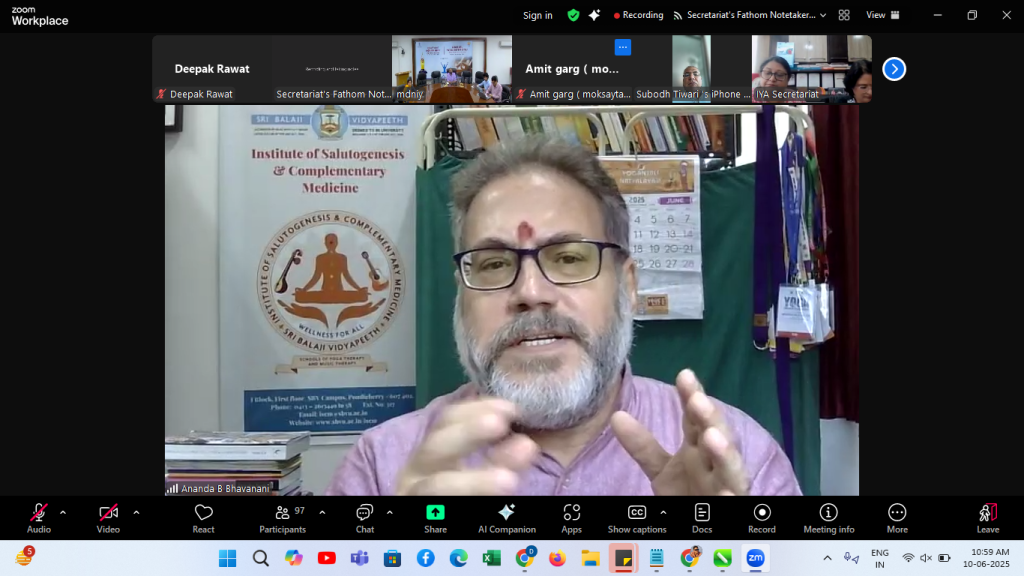A brief Report by Yogasadhaka Nilachal
Introduction
The Continuous Yoga Chikitsa Learning and Education (CYCLE) program of Indian Yoga Association has reached a landmark moment in its journey of nurturing knowledge and practice. With the successful completion of its 18th consecutive monthly session, the initiative celebrates not just longevity, but an unbroken tradition of bringing together some of the finest minds in the field of yoga therapy. This milestone session, titled “Essential Elements of Yoga Therapy in the KYM Tradition,” was led by Yoga Cikitsa Āchārya V.M. Janakiraman, Senior Yoga Therapist, Krishnamacharya Yoga Mandiram (KYM).
Yoga Cikitsa Āchārya V.M. Janakiraman, is a Senior Yoga Therapist at the revered Krishnamacharya Yoga Mandiram (KYM), embodies over two decades of dedicated service to the art and science of yoga therapy. In 2000, he made a life-defining choice by leaving a senior Central Government position to walk the yogic path full-time. Renowned for seamlessly integrating āsana, prāṇāyāma, Vedic chanting, nyāsa, and mudrā, he has guided and inspired students across India and the globe. A respected examiner for QCI and YCB, a key contributor to the Government of India’s Common Yoga Protocol, his work bridges timeless tradition with contemporary application. At KYM, he upholds the enduring truth of the lineage: yoga therapy is not for the disease, but for the unique person who carries it.

From Philosophy to Practice
Janakiraman’s approach draws from Sāṅkhya philosophy and the pañcamaya model of the Taittirīya Upaniṣad, which views human existence through five sheaths:
Annamaya (Physical) – worked on through āsana
Prāṇamaya (Energetic) – addressed via prāṇāyāma
Manomaya (Mental) – supported through dhāraṇā
ijñānamaya (Intellectual) – deepened via nyāsa and mudrā
Ānandamaya (Blissful) – accessed through Vedic chanting
The Breath as a Bridge
Prāṇāyāma prepares the mind for pratyāhāra (withdrawal of the senses), leading to dhāraṇā and samādhi. The KYM method centers on breath as the foundation of yoga therapy:
Each āsana is synchronized with inhalation and exhalation.
Movements are repeated six to eight times with mindful transitions and counterposes.
Vinyāsa krama ensures safety, awareness, and injury prevention.
The KYM Therapy Process
Therapy is seen as an evolving process built on trust and patience. KYM’s therapy model is exclusively one-on-one, consisting of:
Detailed Intake – lifestyle, diet, sleep, medical history
Observation (Darśanam) – posture, gait, body language
Touch Assessment (Sparśanam) – including pulse (nāḍī) reading
Inquiry (Praśnam) – understanding illness from the student’s perspective
Customized Practice – designed for function, not form
Follow-up Sessions – ongoing adaptation of practice
During the session, V.M. Janakiraman ji explained that the stick diagram devised by Yoga Chikitsa Viśārada T.K.V. Desikachar is a key part of the KYM yoga therapy process.
He described it as a practical and personalized visual record of the practice given to a student. Each diagram is drawn by the therapist after the one-on-one consultation and includes:
Simple stick figures representing each āsana in the sequence.
Arrows and breath cues showing when to inhale, exhale, or hold the breath.
Repetitions, timings, and counterposes to ensure safe and balanced practice.
Additional notes for focus, awareness, or modifications.
Janakiraman highlighted that this diagram is never a standard template—it is unique to each individual, reflecting their current condition, capacity, and therapeutic needs. Over time, as the student progresses, the stick diagram is revised, making it a living document of their yoga journey.
He stressed that this method not only helps the student remember the sequence but also reinforces KYM’s central principle: the practice adapts to the person, not the other way around.
Lifestyle and Prevention
Lifestyle as Medicine
“We eat to please the inner Śiva, not the tongue.”
Balanced living—āhāra (food), activity, and rest—forms the backbone of the KYM approach to yoga therapy. Drawing from the Bhagavad Gītā, Janakiraman ji emphasized the importance of moderation in every aspect of life, noting:
Prevention as the Goal
“Pain that is yet to come can be avoided.”
This philosophy extends beyond treatment into the realm of prevention. He reminded participants:
heyaṃ duḥkham anāgatam (PYS 2.16)
In the KYM tradition, the ultimate aim is not merely recovery but the empowerment of individuals to sustain long-term health and well-being through mindful choices and self-awareness. Janakiraman ji taught that the ultimate goal of yoga therapy is the prevention of future suffering. Through one-on-one, individualized guidance, and the integration of āsana, prāṇāyāma, dhāraṇā, and Vedic chanting, practitioners can align body, breath, and mind, creating the conditions for both physical health and inner harmony.
Conclusion
The 18th CYCLE session was a rich exploration of the Essential Elements of Yoga Therapy in the KYM Tradition, offering participants both philosophical depth and practical guidance. Through his clear, experience-based teaching, V.M. Janakiraman ji illuminated how yoga therapy, when rooted in tradition and tailored to the individual, becomes a lifelong tool for healing, prevention, and self-transformation. As the program moves forward, its commitment to preserving and sharing such wisdom ensures that the essence of yoga chikitsa continues to inspire and empower seekers everywhere.